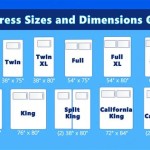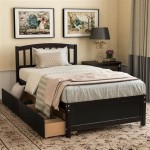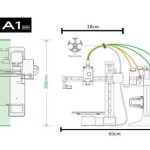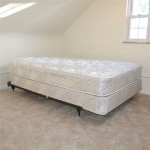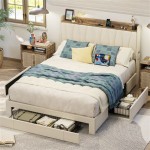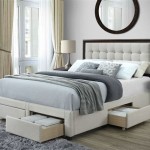Twin Bed Size in Feet: A Comprehensive Guide
The dimensions of a twin bed are a common starting point when furnishing a bedroom, especially for children, teenagers, or guest rooms. Understanding the accurate size in feet is essential for effective space planning, choosing appropriate bedding, and ensuring a comfortable sleep environment. This article provides a detailed examination of the dimensions of a twin bed, exploring its standard size, variations, and factors to consider when selecting a twin bed.
The term "twin bed" refers to a bed designed to accommodate one person. Its compact size makes it a practical choice for smaller rooms or spaces where multiple beds are required. However, the designation "twin" can sometimes be misleading due to variations in mattress sizes and bed frame designs. This necessitates a precise understanding of the standard dimensions and potential deviations.
When discussing bed sizes, the unit of measurement often varies depending on geographical location. While inches are frequently used in the United States, other regions may primarily utilize centimeters or meters. Converting to feet provides a standardized understanding that is readily applicable across various measuring systems.
Understanding the Standard Dimensions of a Twin Bed in Feet
The standard dimensions of a twin bed mattress are 38 inches wide and 75 inches long. To convert these measurements to feet, we divide each by 12 (since there are 12 inches in a foot). This results in a width of approximately 3.17 feet and a length of approximately 6.25 feet. Therefore, the standard twin bed mattress is roughly 3.17 feet by 6.25 feet.
It is crucial to emphasize that these dimensions refer specifically to the mattress size. The overall footprint of the bed frame will invariably be larger, depending on the style of the frame. Factors such as headboards, footboards, and side rails will add to the overall length and width of the bed. To accurately determine the total space required for a twin bed, it is essential to consider the measurements of both the mattress and the frame.
The height of a twin bed can also vary significantly. Some beds are designed to sit low to the ground, while others are raised higher, often with storage space underneath. This height variability is another factor to consider when planning a room layout, especially in situations where vertical space is limited or when accessibility is a concern.
The 3.17 feet by 6.25 feet dimensions provide a solid base for calculating the required area. When considering the bed frame and the necessary clearance around the bed for movement, it becomes apparent that a larger space is needed than just the mattress size. Typical room layouts often allocate between 7 feet by 9 feet for a twin bed, but this depends on the inclusion of other furniture.
While the mattress dimensions provide the sleep surface size, it is advisable to account for an additional 1 to 2 feet around the bed for ease of access and for space for bedside tables or other furniture. This ensures that the bed does not feel cramped and that the room remains functional and comfortable.
Variations in Twin Bed Sizes: The Twin XL
While the standard twin bed dimensions are 38 inches by 75 inches, a variation known as the "Twin XL" exists. The Twin XL bed maintains the same width as a standard twin bed (38 inches or 3.17 feet) but has an extended length of 80 inches. In feet, this translates to a width of 3.17 feet and a length of approximately 6.67 feet.
The Twin XL bed is primarily designed to accommodate taller individuals or students in dormitories. The extra length provides additional legroom, making it a more comfortable option for adults or growing teenagers. This is a significant factor for overall sleep comfort, and often the few inches makes a considerable difference for the sleeper.
When considering the Twin XL, it is essential to note that standard twin bedding may not fit properly. Specifically, the sheets may be too short to adequately cover the mattress. Therefore, it is necessary to purchase Twin XL-specific bedding to ensure a proper fit and maintain comfort.
The frame requirements for a Twin XL bed are also different from those of a standard twin bed. The use of a standard twin frame for a Twin XL mattress will result in an overhang at the foot of the bed. It's therefore essential to acquire a frame specifically designated for the Twin XL size. This ensures proper support and prevents potential damage to the mattress.
The decision between a standard twin and a Twin XL bed should be based on the individual's height and sleeping preferences. For children and smaller individuals, a standard twin bed is typically sufficient. However, for taller individuals or those who prefer more legroom, the Twin XL is a more suitable choice.
Another factor to consider when selecting between a standard twin and a Twin XL bed is the availability of space. While the difference in length is only 5 inches, this can be a significant consideration in smaller rooms. Measuring the available space carefully is crucial to ensure that the chosen bed size fits comfortably within the room without making it feel cramped or overcrowded.
Factors to Consider When Selecting a Twin Bed
Choosing the right twin bed involves more than simply understanding the dimensions. Several factors contribute to making an informed decision, including the user's age, height, and sleeping habits, as well as the intended use case and space availability.
For children, a standard twin bed is often an appropriate choice. Its smaller size is well-suited to their physical dimensions, and it provides ample space for comfortable sleep. However, it's essential to consider their growth rate. If it's anticipated that the child will outgrow the bed quickly, a Twin XL might be considered as a longer-term solution. The standard twin size also allows for a wider range of bedding choices.
For teenagers and adults, the decision between a standard twin and a Twin XL is often based on height. Individuals taller than approximately 5'10" (1.78 meters) may find the Twin XL bed more comfortable due to the added legroom. It is often thought of as a temporary solution while saving up for a bigger bed.
The intended use case also plays a significant role in the selection process. If the twin bed is intended for a guest room, a standard twin bed may be sufficient. However, if the guest room is frequently used by taller individuals, a Twin XL bed might be a more accommodating choice. The comfort level of the guest will affect how often the guest will use the room.
Space availability is a critical factor. In smaller rooms, a standard twin bed may be the only practical option. Carefully measuring the room's dimensions and considering the placement of other furniture is vital to ensure that the bed fits comfortably without compromising the room's functionality. If the space is slightly bigger, a Twin XL may be a better option despite the size, due to the added comfort.
The type of mattress used on the twin bed also needs to be considered. Different mattress types offer different levels of support and comfort. Options include innerspring mattresses, memory foam mattresses, and hybrid mattresses. The choice of mattress should be based on individual preferences and sleeping needs.
The aesthetic design of the bed frame is another factor. Twin beds are available in a wide range of styles, from simple and functional designs to more elaborate and decorative options. The frame should complement the overall décor of the room and reflect the occupant's personal style. The design is often overlooked but contributes greatly to the feel and comfort of the room.
The overall height of the bed is sometimes overlooked. Some individuals may prefer a lower bed to make it easier to get in and out, while others may prefer a higher bed for aesthetic reasons or to provide under-bed storage. The bed height should be chosen based on personal preferences and physical needs. This is highly important for sleepers who have physical limitations.
Finally, budget is always a consideration. Twin beds are available at a wide range of price points, from basic models to more expensive, high-end options. It's important to establish a budget before starting the shopping process and to consider the long-term value and durability of the chosen bed. The features and styles should be weighted against the affordability of the bed and its accompanying necessities. A long lasting bed, while initially being more expensive, may ultimately be more cost effective.

Bed Measurements

Twin Vs Full Mattress Comparing Dimensions Cost More

Bed Sheet Sizes And Dimensions Guide Dreamcloud

Mattress Dimensions And Sizes Which Bed Is Right For You

Twin Mattress Size Standard Dimensions

Single Vs Twin Bed What S The Difference Sleep Authority

Mattress Sizes And Dimensions Guide 2025 Best Brand

Metro Twin Xl Platform Bed With Open Foot Board In Walnut

Twin Xl Vs Bed Size Sleep Advisor

Bed Sizes Why Would You Need A 9 Foot Well I M Glad Asked Have Dogs And Husband Who Sleeps In The Middle It Be Perfect For


